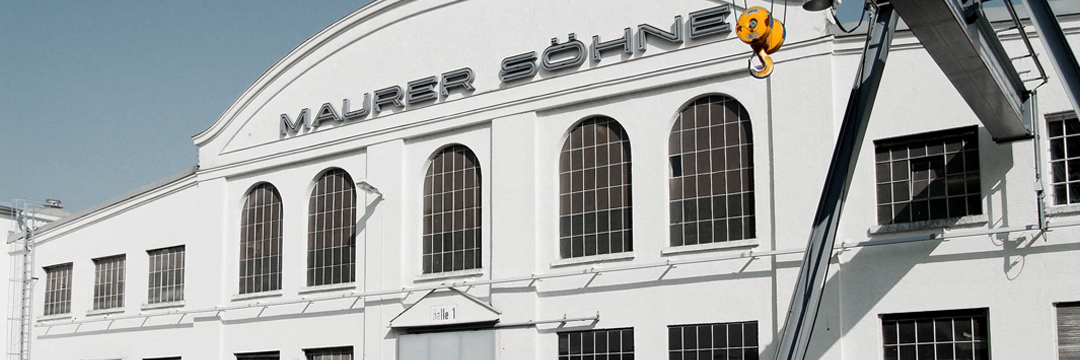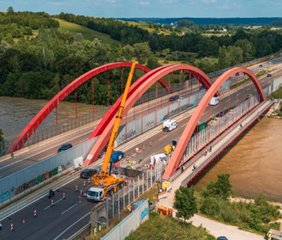
Complete replacement of expansion joints on one weekend

Augsburg. It took MAURER just 57 hours to replace the roadway expansion joints on the three-lane highway bridge at the highway junction Augsburg – construction work that normally would have resulted in at least three weeks of closures. This was made possible by newly developed solutions to connect ex- pansion joints to structures and by shifting working time from the construction site to production, requiring a modified expansion joint featuring almost twice the weight and twice the height compared to the standard design. In addition, a mobile bridging system was used that can be quickly opened and closed.
Expansion joint replacement on a three-lane highway bridge like that of the federal highway 8 in Gersthofen near Augsburg is anything but a source of joy, both for operators and drivers. “As a private highway operator, we have the obligation to ensure availability,“ explains Oliver Saga, Managing Director of utobahnplus A8 GmbH. “Each closed lane, each hour needed causes costs.” Hence, a technical innovation such as replacing the expansion joints on one weekend only was a highly interesting option. At the same time, the construc- tion site at the A8 was the ideal location to demonstrate the performance capa- bility of this innovative system in combination with further MAURER products: “For MAURER, it was the third replacement of expansion joints of this kind with- in three months,” explains Josef Reger, Head of Assembly Munich at MAURER.
The federal highway 8 Munich–Stuttgart is one of the European main roads and a focal point in local traffic since it crosses the river Lech between the junctions Augsburg-Ost and -West. During a routine bridge inspection, damages were detected at a bolted noise-reduced lamella expansion joint installed 14 years ago, which was self-evidently not delivered by MAURER.
Expansion joints are flexible structural elements accommodating temperature- induced and other movements at the bridge ends towards the mainland. At the same time, they ensure that traffic can run smoothly without restrictions regardless of the displacement condition (up to 190 mm at the Lech bridge).
More production time, less construction site time
The first time-consuming work in conventional replacement of expansion joints is disassembly since the expansion joint is included in the bridge’s build- ing structure. After that, the reinforcement must be complemented, which is also time-consuming, followed by detailed formwork and hardening of the concrete. This three-week work is completely omitted with the new expan- sion joint replacement system since MAURER is shifting process steps from the construction site to the upstream production process following the motto “preliminary work and preparation without full closure”.
This is achieved by using a modified swivel-joist expansion joint. This type of expansion joint is movable in all directions: transversely and longitudinally to the direction of traffic as well as vertically. Due to their design, MAURER Expansion Joints are fatigue-proof, enabling their approval for a service life of 50 years.
Normally, these expansion joints feature anchor loops on both sides that are connected with the bridge reinforcement and then embedded in concrete. The new construction looks entirely different since it is connected in a different way. Instead of using anchor loops it is placed in a mortar bed and fastened on one side. On the other side, it is welded onto the old roadway expansion joint. “With this new principle, we are capable of replacing almost any expansion joint, no matter what the actual conditions at the construction site may be. We have developed adaptable components for both steel and concrete connections,“ explains Reger.
57 hours for disassembly and assembly
The replacement of the expansion joints started on Friday at 8 p.m. “We had de- manded a meticulous time schedule from MAURER for the weekend to enable us to continuously monitor whether each working step was right on schedule,” reports Saga. Materials and construction site trailers had been delivered be- forehand and preparatory work on the abutment made. The disassembly of the previously installed expansion joint was executed step-by-step, thus enabling traffic to run on at least one lane during this phase. The gradually exposed expansion gap was bridged with the MMBS system.
MMBS stands for MAURER Modular Bridging System. Basically, each module consists of three steel plates that are connected to each other by joints. For working at the roadway expansion joint, the middle plate is unfolded, the ramp element on the drive-off side folds towards the bottom, and both are verti- cally fixed. The elements with a weight of approximately 3 tons are placed next to each other covering the structural gap and fastened without major intru- sion into the structure. They are trafficable with all loads – with up to 80 km/h. For the Lech bridge (roadway width 16m), 11 MMBS elements were used.
Creating space for the new expansion joint
Intrusion into the structure was only made towards the bridge side. At the bridge, solely the width of the old expansion joint recess was cut out of the superstructure concrete by means of a rope saw and lifted out in three parts with a mobile crane to create space for the new expansion joint. For the support plate, over the entire width a strip of 30 cm width and 10 cm depth was reamed from the asphalt and superstructure concrete above the superstructural rein- forcement.
Only 5.5 hours of full closure
On Saturday night, at 11:30 p.m. sharp, the full closure commenced and all MMBS elements were folded out. The remaining loose parts of the old expan- sion joint were disassembled, all components firmly anchored in the concrete remained in place on the abutment side.
Subsequently, 2.5-m-high steel supports were lifted into position. The five supports are positioned on the abutment and transfer vertical loads. On Sunday morning around 1:30 a.m., lifting-in of the 16 m long new expansion joint with a weight of 12 t commenced. Fast work was required for the mortar bed at the contact face of the new expansion joint since extremely rapid-hardening con- crete was used. Thereafter, the expansion joint was lifted into position, pre- cisely as to height and position, and welded on. After one hour, the concrete had hardened to such an extent that the support plate on the bridge side could be anchored in the bridge with special dowels. The dowels are designed to accommodate dynamic loads.
Towards the abutment side, the new expansion joint was welded onto the ex- isting edge profile. Full closure could be ended just in time on Sunday morning at 5 a.m. “Further welding and doweling of the expansion joint, sealing, and the insertion of poured asphalt on the superstructure site as well as various work such as the assembly of the supports in the abutment were executed on schedule. Since Monday, July 19, 5:00 a.m., the new XLS 200 Hybrid is fit for traffic,“ reports Robert Beyrle, construction manager at MAURER.
The new expansion joint features additional characteristics. It was manufac- tured in hybrid design, which means: the parts of corrosion-prone components that are crossed by traffic are made of stainless steel. Moreover, the expan- sion joint is noise-reduced. Contrary to the predecessor construction that was found defective, the noise-reducing rhomboid elements are not bolted but welded on, thus ensuring a demonstrably high service life as well as a sustain- ably reliable function.
Direct client was autobahnplus A8 GmbH. MAURER performed the construc- tion work including all accessory crafts jointly with dependable partners from the construction industry.
Quick facts about MAURER SE
MAURER SE is a leading specialist in mechanical engineering and steel construc- tion with over 1,000 employees worldwide. The company is market leader in the area of structural protection systems (bridge bearings, roadway expansion joints, seismic devices, tuned mass dampers, and monitoring systems). It also develops and produces vibration isolation of structures and machines, roller coasters and Observation Wheels as well as special structures in steel construction.
MAURER participates in many spectacular large-scale projects worldwide, like, for example, the world’s biggest bridge bearings in Wazirabad, earthquake- resistant expansion joints for the Bosporus bridges, tuned mass dampers in the Baku and Socar Tower, or uplift bearings for the Zenit Arena in St. Petersburg. Complete structural isolations range from the Acropolis Museum in Athens to the new major airport in Mexico. Spectacular amusement rides include, for example, umadum – the Munich Observation Wheel, BOLTTM the first roller coaster on a cruise ship, the Rip Ride Rockit Roller Coaster in the Universal Studios Orlando, or the worldwide first duelling roller coaster at the Mirabilandia Park in Ravenna.
Contact Head Office
MAURER SE
Frankfurter Ring 193
80807 Munich
Germany
Phone +49. 89. 32394-0
Mail







